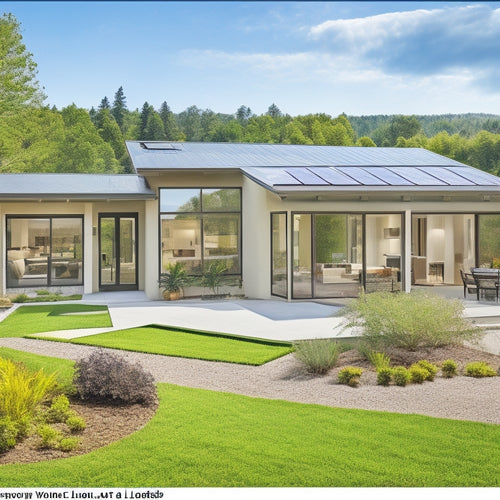
7 Steps to Buy Solar Energy for Home or Business
Share
You're ready to utilize the power of solar energy for your home or business, and you want to know where to start. Begin by calculating your average daily energy consumption and evaluating your location's suitability for solar panels, considering factors like sunlight patterns, roof space, and shading. Next, choose a solar panel system that fits your needs, research and select a reputable provider, and examine the financial incentives available. Guarantee proper installation and maintenance, and monitor your system's performance to optimize its energy production. As you take these steps, you'll uncover more details that will help you make an informed decision and maximize your investment.
Key Takeaways
- Determine your energy needs by calculating average daily energy consumption and identifying energy usage patterns to estimate solar panel system size.
- Assess your location's suitability for solar energy by evaluating local sunlight patterns, shading, and obstructions, as well as roof space and orientation.
- Choose a suitable solar panel system based on your energy needs, including type of solar panels, installation options, and provider reputation.
- Research and select a provider with a good reputation, experience, and customer support, and evaluate financial incentives and financing options.
- Ensure proper installation and maintenance of your solar energy system, including regular monitoring, inspections, and cleaning to optimize performance.
Determine Your Energy Needs
To accurately evaluate your solar energy needs, you must first calculate your current energy consumption. This involves identifying your power requirements and understanding your energy usage patterns.
Start by gathering your past electricity bills to determine your average daily energy consumption in kilowatt-hours (kWh). You can also use online energy calculators or consult with a professional to help you estimate your energy needs.
Next, consider your energy usage patterns. Are you a heavy user of appliances, lighting, and electronics during the day or night? Do you have energy-intensive systems like air conditioning or electric heating? Understanding your energy usage patterns will help you determine the size of the solar panel system you need.
Based on your energy consumption and usage patterns, you can then estimate the size of the solar panel system required to meet your power requirements. This will help you determine the number of solar panels you need, the type of equipment required, and the installation costs.
Assess Your Location's Suitability
You'll need to evaluate your location's potential for utilizing solar energy by examining local sunlight patterns, including the amount of shade your property receives and the number of sunny days per year.
Additionally, you should assess your roof's space availability, factoring in its size, orientation, and structural integrity.
Local Sunlight Patterns
As you consider utilizing solar energy, evaluating your location's suitability is vital, and it starts with understanding local sunlight patterns. This is important because the amount of sunlight your location receives directly impacts the efficiency of your solar panels.
Understanding local sunlight patterns involves analyzing several key factors:
-
Sunlight intensity: The amount of solar energy your location receives per unit area, which varies by region and time of year.
-
Seasonal variations: The changes in sunlight patterns throughout the year, with more intense sunlight during summer months and less during winter.
-
Shading and obstruction: The presence of trees, buildings, or other obstacles that can block sunlight and reduce its intensity.
Roof Space Availability
Beyond sunlight patterns, evaluating your location's suitability for solar energy also depends on the availability of roof space.
You'll need a sufficient area to accommodate the solar panels, considering the size and number of panels required to meet your energy needs. Consider the roof's orientation, as south-facing roofs receive the most sunlight. East- and west-facing roofs can also work, but north-facing roofs are generally not suitable.
Conduct a shading analysis to identify any obstacles that might block sunlight from reaching your roof. This includes trees, buildings, and other structures that could cast shadows on your roof.
You'll want to make sure that your roof receives sufficient sunlight throughout the day. If your roof is partially shaded, you may need to trim trees or consider installing a tracking system that adjusts the panels' angle to maximize energy production.
Assess your roof's size, material, and condition to determine if it can support the weight of the solar panels.
Verify that your roof is structurally sound and won't require significant repairs before installing the solar energy system. By evaluating these factors, you'll get a clear depiction of your roof's suitability for solar energy.
Choose a Solar Panel System
How complex is the solar panel system you need? This depends on your energy requirements, roof size, and local building codes.
You'll need to evaluate the type of solar panels, installation options, and system configuration to guarantee a seamless integration with your existing electrical infrastructure.
You have three primary options to choose from:
-
Monocrystalline solar panels: High-efficiency panels ideal for small roofs with high energy demands.
-
Polycrystalline solar panels: Cost-effective panels suitable for larger roofs with moderate energy needs.
-
Thin-film solar panels: Flexible and lightweight panels perfect for unusual roof shapes or sizes.
When selecting a solar panel system, evaluate the installation options: roof-mounted, ground-mounted, or tracking systems.
Roof-mounted systems are the most common, while ground-mounted systems offer more flexibility.
Tracking systems, though more expensive, optimize energy production by adjusting to the sun's movement.
Research and Select a Provider
With your solar panel system requirements in mind, it's time to find a provider that can deliver a high-quality installation. You want a provider with a solid reputation, competitive pricing, and flexible contract terms. Research local and national providers, reading reviews and asking for referrals from friends, family, or colleagues who've gone solar.
When evaluating providers, consider the following key factors:
| Factor | Considerations |
|---|---|
| Provider Reputation | Check online reviews, ratings, and testimonials. Look for certifications like NABCEP (North American Board of Certified Energy Practitioners). |
| Contract Terms | Review the length of the contract, warranty terms, and maintenance responsibilities. Verify the contract includes a clear payment schedule and dispute resolution process. |
| Experience and Knowledge | Confirm the provider's experience with installations similar to yours (residential or commercial). Check their licenses, insurance, and certifications. |
| Customer Support | Evaluate the provider's customer support, including response times, repair services, and maintenance schedules. |
Evaluate Financial Incentives Available
As you maneuver through the process of buying solar energy for your home or business, financial incentives can greatly impact the overall cost and feasibility of your solar panel system.
These incentives can considerably reduce your upfront costs, making solar energy a more accessible and affordable option.
Some financial incentives to investigate include:
-
Federal tax credits: You may be eligible for a tax credit of up to 26% of the total cost of your solar panel system.
-
State rebates: Many states offer rebates or cash incentives for installing solar panels, which can further reduce your costs.
-
Financing options: You may be able to secure financing options with low or no interest rates, making it easier to install solar panels without breaking the bank.
Ensure Proper Installation and Maintenance
You've secured the necessary financial incentives, now it's time to focus on the physical installation and ongoing maintenance of your solar panel system. Proper installation is vital to guarantee your system operates at maximum efficiency.
Look for installers who use advanced installation techniques, such as micro-inverters or power optimizers, which can increase energy output and reduce maintenance needs. Additionally, verify your installer provides a thorough maintenance schedule, including regular inspections and cleaning, to prevent issues and optimize performance.
Regular maintenance is important to extend the lifespan of your solar panel system. A well-maintained system can last up to 30 years or more.
Your maintenance schedule should include tasks such as cleaning the panels, inspecting electrical connections, and monitoring system performance. You may also want to take into account hiring a professional maintenance service to confirm your system is properly cared for.
Monitor and Optimize Performance
You'll want to track your solar energy system's performance to guarantee it's producing the expected amount of energy.
By monitoring your system's output, you'll be able to identify any energy loss and take corrective action.
This data will help you optimize your system's performance and maximize your return on investment.
Track Energy Production
By the time your solar energy system is up and running, you're likely keen to see how it's performing.
You've made a significant investment, and you want to guarantee it's generating the amount of energy you expected. This is where energy tracking comes in.
Production monitoring is essential to understanding your system's performance.
With real-time data, you can:
- Identify areas of inefficiency and optimize your system for better performance
- Verify that your system is producing the expected amount of energy
- Make informed decisions about maintenance and upgrades
Identify Energy Loss
Monitoring your solar energy system's performance in real-time allows you to pinpoint areas of inefficiency and optimize its operation. This step is essential in identifying energy loss and maximizing your system's energy efficiency.
You'll be able to detect issues such as shading, soiling, or malfunctioning components that can reduce your system's thermal performance.
By analyzing your system's real-time data, you can identify patterns and trends that indicate energy loss. This data can help you pinpoint specific areas of improvement, such as adjusting the angle of your panels or cleaning them regularly.
You can also use this data to optimize your energy usage during peak hours, reducing waste and saving you money on your energy bills.
Regular monitoring also enables you to detect potential issues before they become major problems, reducing downtime and extending the lifespan of your system.
Frequently Asked Questions
Can I Install Solar Panels on a Rented Property?
You can install solar panels on a rented property if you negotiate a tenant agreement with your landlord, considering options like solar leases that benefit both parties, ensuring a mutually beneficial and sustainable energy solution.
How Long Does a Typical Solar Panel Warranty Last?
You'll typically find that a solar panel warranty lasts around 25 years, covering defects and performance issues, which is roughly the same as the expected panel lifespan, ensuring you're protected for most of the system's operational life.
Are Solar Panels Affected by Extreme Weather Conditions?
You wonder if solar panels can withstand extreme weather conditions. Rest assured, modern solar panels are built with durability in mind, designed to resist extreme weather impacts, including hail, high winds, and intense temperatures, ensuring your power supply remains stable.
Can I Sell Excess Energy Back to the Grid?
You're generating excess energy like a overflowing tank, and yes, you can sell it back to the grid through net metering policies, which vary by state, offering different energy buyback rates, allowing you to offset your utility bills.
Do Solar Panels Require Regular Cleaning for Optimal Performance?
You'll need to clean your solar panels regularly for maximum energy utilization, as dirt and debris reduce efficiency; typically, you'll want to clean them every 6-12 months, depending on your location and solar panel maintenance requirements.
Conclusion
You've taken the first step towards utilizing the power of the sun! Now, go ahead and take the leap. Remember, "well begun is half done." By following these 7 steps, you'll be well on your way to reaping the benefits of solar energy for your home or business. With the right system and provider, you'll be generating clean energy and saving money in no time. Stay on top of maintenance and monitoring to guarantee peak performance, and get ready to bask in the rewards of your investment.
Related Posts
-

Energy-Efficient Lighting Solutions for Sustainable Buildings
For sustainable buildings, energy-efficient lighting solutions, like LEDs, offer multiple benefits. These bulbs last ...
-

Solar Power Advantages for Rural Communities
Solar power presents numerous advantages for rural communities. You can greatly reduce energy costs, potentially by u...
-

Passive Solar Design Strategies for Homes
To effectively implement passive solar design strategies in your home, focus on ideal building orientation and strate...


